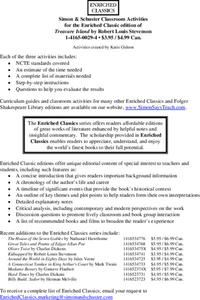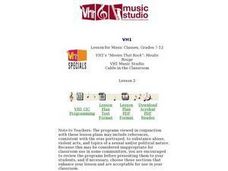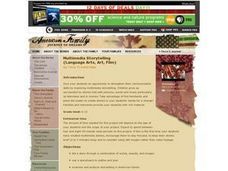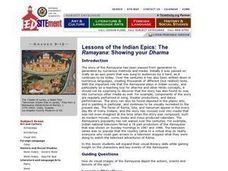Student Achievement Partners
Eleven
Turning 11 comes with a range of emotions. Explore those emotions by reading the short story "Eleven" by Sandra Cisneros. Readers analyze the main character's reactions to the events of her day. Then, they write an essay describing what...
Wuthering Heights
The Reader’s Guide to Emily Bronte's Wuthering Heights
Researching the characters, setting, and background history of a work of literature enhances interest and improves reading comprehension. An interactive website contains a wealth of resources related to Emily Bronte's novel Wuthering...
College Board
2002 AP® English Literature and Composition Free-Response Questions
Good or evil? Some characters never identify themselves as either. Scholars create essays in which they examine morally ambiguous characters. Writers also analyze and write essays about the use of poem titles and take a close look at the...
PBS
Their Eyes Were Watching God: The Impact of Language
Author, filmmaker, and anthropologist Zora Neale Hurston was also a dialectologist. The dialogue of the characters in her novel Their Eyes Were Watching God reveals her fascination with accents and dialects. A short video from the Great...
Simon & Schuster
Curriculum Guide to: Great Expectations by Charles Dickens
Great Expectations can prove to be a challenge for instructors who choose to use Dickens's novel as required reading. Here's a curriculum guide that includes lessons that address some of these challenges. The first lesson in critical...
Simon & Schuster
Classroom Activities for Treasure Island by Robert Louis Stevenson
Readers take part in three activities after reading Robert Louis Stevenson's Treasure Island. To understand the importance of diction, class members analyze Stevenson's characters' language to denote their social status. After completing...
Overcoming Obstacles
Problem Solving Techniques
Participants in the first lesson of the "Problem Solving Module" discover that the techniques used to solve problems follow the same steps they practiced in the "Decision Making Skills Module." Groups focus on different characters in a...
Anti-Defamation League
On-Screen Diversity: Why Visibility in Media Matters
Characters play a significant role in why we like certain shows and movies but are the characters we watch representing the diverse society in which we live? Scholars examine this question through thoughtful discussion about popular...
K20 LEARN
We've Got Character! Literary Analysis: Characterization
How authors bring characters to life and make them believable is the focus of a lesson on characterization. Readers closely examine passages from To Kill a Mockingbird and Dreamland Burning, noting details that reveal the character's...
Curated OER
Cinderella
Explore positive and negative character traits and universal themes in the story of Cinderella with primary learners. Story elements are reviewed and discussion questions are listed. Learners practice retelling the story and begin a...
Curated OER
Diary
Keeping a journal can be one of the most enjoyable writing tasks that children engage in. They get to write about what they want to write about - not what the teacher tells them to write about! Here, young writers pretend they are a...
Curated OER
The Gingerbread Man Trail
What a fun way to familiarize your young learners with friendly faces on campus! Scholars read "The Gingerbread Man," discussing the characters he meets. Then, they examine a map of the campus, placing photos of employees (such as the...
VH1
Lesson 2: Moulin Rouge
The pop movie Moulin Rouge was based on the opera La Boheme. Learners watch the last 30 minutes of each musical to compare and contrast social opposites. They'll first discuss the social differences of the main characters and how those...
Curated OER
Storytelling of the Four Tribes of Nevada
Learners work in groups to identify the major characters and events found in a Nevada Native American folklore story. Each of the groups takes on the role of a different tribe, and they are given a story from that tribe's oral history....
Curated OER
"Spelldown" by Becky Mushko
Learners read Spelldown, by Becky Mushko and consider how it portrays the Appalachian community. They define and discuss vocabulary presented in the story and write a comparison/contrast paper analyzing two of the story's characters. The...
Curated OER
Shakespeare's Othello and the Power of Language
Students read and analyze Iago's rhetoric in specific monologues and dialogues with other characters, examine what Iago says and how he says it, define some basic rhetorical terms, and discover the sometimes dangerous power of language.
Curated OER
Scripting the Past: Exploring Women's History Through Film
Explore women's history through films and filmmaking. An innovative research project prompts class members to create their own screenplay about a figure in women's history. After outlining their characters, settings, and plots, young...
Curated OER
Lesson #2 ~ Nanoscience and Nanotechnology
You might love this lesson, or you might not. Basically, high school scientists read through a script in which someone interviews a physicist, a biologist, and a chemist in regard to their use of nanotechnology. The names of the involved...
Curated OER
When Art Conveys a Political Message
Twelfth graders learn art is an effective way to convey a political message. They learn how political messages are created to convey a message. They analyze a piece of artwork and then write a short paragraph from the point of view of...
Curated OER
Folktale Writing
Review literary analysis techniques with this reading lesson about folktale writing. Middle schoolers read different folktales from many authors, and write their own folktales to share with the class. They identify the plot, morals and...
Curated OER
Multimedia Storytelling
Experiment with multimedia storytelling. After watching a segment of American Family, first, middle and high schoolers tell a story about their families, clarifying the setting, characters, and script. They work on setting their story in...
Scholastic
Defining Conflict Using "The Interlopers"
Feeling conflicted? Work out those issues with a language arts lesson on internal and external conflict. Using "The Interlopers" by Saki, class members identify the conflicts between the characters before writing their own short stories...
Curated OER
The Ramayana: Showing your Dharma
Students identify characters and events from the Ramayana. They discuss ways in whcih the images convey non-verbal information and messages. They discuss similarities and differences in the visual and verbal tellings of the Ramayana.
Curated OER
"Zigzag"
Second and third graders explore point of view and read and discuss the book "Zigzag." They listen to the story "The Five Blind Men and the Elephant" and discuss point of view, identify the point of view of the main character Zigzag, and...
Other popular searches
- Characters and Setting
- Main Characters
- Describing Characters
- Cinderella Characters
- Analyzing Characters
- Charlotte Web Characters
- Character's Feelings
- Character's Motivation
- Cartoon Characters
- Venn Diagram Two Characters
- Adolescent Characters
- Setting Plot Main Characters

























